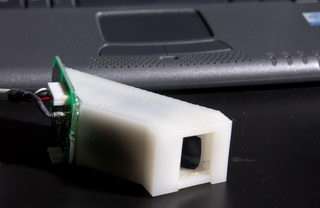New technology developed for more compact, inexpensive spectrometers

Being the delicate optical instruments that they are, spectrometers are pretty picky about light. But Georgia Tech researchers have developed a technology to help spectrometers -- instruments that can be used as the main parts of sensors that can detect substances present in even ultra-small concentrations -- analyze substances using fewer parts in a wider variety of environments, regardless of lighting.
The technology can improve the portability while reducing the size, complexity, and cost of many sensing and diagnostics systems that use spectrometers. The technology has appeared in Applied Optics, Optics Express and Optics Letters and was presented as an invited talk at the IEEE Lasers and Electro-Optics Society Annual Meeting 2005.
Conventional spectrometers have multiple parts -- a narrow slit, a lens (to guide light), a grating (to separate wavelengths), a second lens and a detector (to detect the power at different wavelengths). The Georgia Tech team's goal was to combine all these pieces into two parts, a volume hologram (formed in an inexpensive piece of polymer) and a detector, to create a compact, efficient and inexpensive spectrometer that could be used for multiple spectroscopy and sensing applications.
"This technology is very useful for low-end spectrometers, but at the same time, there are many applications that require high-end spectrometers. This technology could convert a portion of a complex, high-end system into a much more versatile and light system," said Ali Adibi, head of the project and an associate professor in the School of Electrical and Computer Engineering.
Because of its light weight and relative insensitivity to optical alignment, the new design helps create more versatile and portable spectrometers for several applications where portability had been difficult. For instance, the technology would make hand held devices possible for carbon monoxide detection or on-the-spot blood analysis and other biomedical applications.
One of the key advantages to the new spectrometer is its insensitivity to alignment. Spectrometers are very sensitive to the direction and wavelength of light and several of their parts are devoted to keeping the light correctly directed.
But the Georgia Tech team was able to incorporate those necessary alignments along with the focusing functions into a volume hologram. This hologram is recorded by the interference pattern of two beams in a piece of photopolymer.
"There were lots of challenges because the light we need to analyze is diffuse in nature," Adibi said.
Conventional spectrometers work the best under collimated light (i.e. light moving in only one direction). However, the optical signal needed for practical sensing applications is diffuse. This problem is solved in conventional spectrometers by blocking light in all but one direction using a slit and a lens, but this also results in considerable power loss and lower efficiency.
"By choosing the appropriate hologram, we have no collimating hardware in our system. We have further demonstrated the capability of improving the throughput by using more complex holograms, which are recorded similar to less complex holograms, in our spectrometer without adding to the actual complexity of the system," Adibi added.
The Georgia Tech team has a prototype for a lower-end spectrometer comparable to those currently on the market but for a considerably lower cost, Adibi said. Their research will now focus on developing more complex systems by using specially designed volume holograms to improve the efficiency -- and thus the sensitivity -- of our spectrometers, Adibi added.
Source: Georgia Institute of Technology















